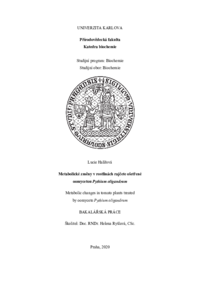Metabolické změny v rostlinách rajčete ošetřené oomycetou Pythium oligandrum
Metabolic changes in tomato plants treated by oomycete Pythium oligandrum
bachelor thesis (DEFENDED)

View/
Permanent link
http://hdl.handle.net/20.500.11956/120056Identifiers
Study Information System: 197357
Collections
- Kvalifikační práce [20339]
Author
Advisor
Referee
Dračínská, Helena
Faculty / Institute
Faculty of Science
Discipline
Biochemistry
Department
Department of Biochemistry
Date of defense
27. 7. 2020
Publisher
Univerzita Karlova, Přírodovědecká fakultaLanguage
Czech
Grade
Excellent
Pythium oligandrum patří mezi unikátní mikroorganismy používané v biologické ochraně rostlin, která je stále častěji využívána v oblasti udržitelného zemědělství. Hledání nových perspektivních kmenů vyžaduje následnou analýzu z hlediska jejich vlivu na rostlinný metabolismus. V této práci byl sledován vliv moření semen rajčete jedlého (Solanum lycopersicum L. cv. Micro-Tom) izoláty Pythium oligandrum na metabolismus rostlin po vystavení infekci houbovým patogenem Alternaria brassicicola s důrazem na antioxidační systém. Alternaria brassicicola je nekrotrofní houbový patogen, který způsobuje černou skvrnitost na zemědělských plodinách, zejména z čeledi brukvovitých (Brassicaceae). Rozpoznání patogenu je spojeno s hypersenzitivní reakcí, jejímž základním znakem je tvorba superoxidových radikálů. Reaktivní formy kyslíku fungují v nízkých koncentracích jako signální molekuly, ale ve vysokých poškozují buněčné komponenty a vedou až k apoptóze buňky. K udržení redoxní rovnováhy využívá rostlina systém antioxidačních enzymů a antioxidantů. Aktivita vybraných antioxidačních enzymů katalasy a isoforem superoxiddismutasy byla po infekci patogenem Alternaria brassicicola zvýšena. Na druhé straně obsah fenolických látek, které jsou spjaté s antioxidační kapacitou, zůstal nezměněn. Také byla detekována zvýšená...
Pythium oligandrum is one of the unique microorganisms increasingly used in biological plant protection in sustainable agriculture. The search for new promising strains requires subsequent analysis in terms of their effect on plant metabolism. In this work, the effect of tomato seed treatment (Solanum lycopersicum L. cv. Micro-Tom) by Pythium oligandrum isolates on plant metabolism after exposure to the fungal pathogen Alternaria brassicicola with emphasis on the antioxidant system was studied. Alternaria brassicicola is a necrotrophic fungal pathogen that causes black spots on agricultural crops, especially from the Brassicaceae family. Pathogen recognition is associated with a hypersensitivity reaction, which features formation of superoxide radicals. Reactive oxygen species function at low concentrations as signalling molecules, but at high concentrations they damage cellular components and lead to cell apoptosis. To maintain redox balance, the plant uses a system of antioxidant enzymes and antioxidants. The activity of selected antioxidant enzymes catalase and superoxide dismutase isoforms was increased after Alternaria brassicicola infection. On the other hand, the content of phenolic compounds, which are associated with antioxidant capacity, remained unchanged. The increase in activity of...
